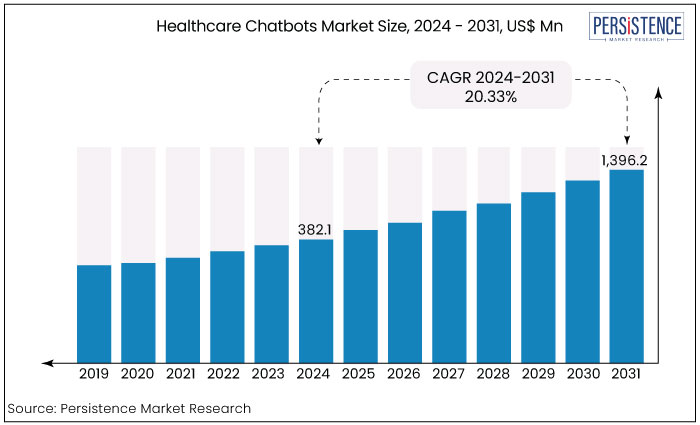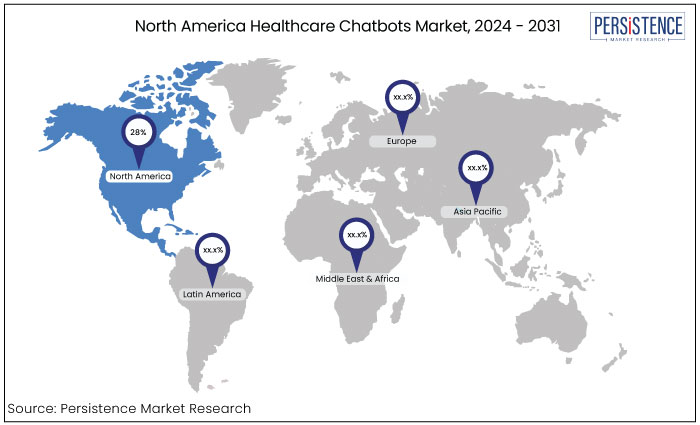ID: PMRREP31960| 170 Pages | 8 Jul 2024 | Format: PDF, Excel, PPT* | Healthcare

The global market for healthcare chatbots is anticipated to increase from US$382.1 Mn in 2024 to US$1.4 Bn by the end of 2031. The market is expected to expand at a CAGR of 20.33% during the forecast period from 2024 to 2031.

Key Highlights of the Market
|
Attributes |
Key Insights |
|
Market Size (2024E) |
US$382.1 Mn |
|
Projected Market Value (2031F) |
US$1.4 Bn |
|
Forecast Growth Rate (CAGR 2024 to 2031) |
20.33% |
|
Historical Growth Rate (CAGR 2019 to 2023) |
18.43% |
Healthcare chatbots have emerged as transformative tools in the healthcare industry in recent years, offering innovative solutions to streamline patient care, improve operational efficiencies, and enhance patient engagement.
One of the primary drivers for the healthcare chatbots market is the increasing demand for accessible and immediate healthcare services. Patients today expect quick responses and easy access to medical information and services, which traditional healthcare systems often struggle to provide efficiently.
Another crucial driver is the emphasis on cost-effectiveness and operational efficiency within healthcare organizations. Chatbots streamline administrative processes, freeing up healthcare professionals to focus more on patient care. AI healthcare chatbots are intelligent virtual assistants powered by artificial intelligence (AI) that are transforming the way patients interact with the healthcare system
By automating repetitive tasks like updating patient records, providing follow-up instructions, and sending appointment reminders, chatbots help optimize resource allocation and improve workflow efficiency. This efficiency gains significance amid rising healthcare costs and the increasing pressure to deliver high-quality care with limited resources.
Healthcare chatbots fill this gap by offering 24/7 availability. These chatbots further allow patients to receive instant answers to their queries, schedule appointments conveniently, and even conduct preliminary health assessments from the comfort of their homes.
AI-powered virtual assistants leverage natural language processing (NLP) and machine learning algorithms to interact with users, provide information, offer diagnostic support, schedule appointments, and even deliver personalized health advice.
Ongoing advancements in AI and NLP technologies are enhancing the capabilities of healthcare chatbots. These bots can now interpret complex medical inquiries, understand context, and provide accurate responses, making them more reliable tools for patient interaction.
The healthcare chatbots market has experienced significant growth over the past decade, driven by technological advancements, increasing healthcare costs, and the growing demand for accessible healthcare solutions.
The market saw a rapid adoption of chatbots across various healthcare settings, including hospitals, clinics, pharmacies, and telemedicine platforms. Chatbots played a crucial role during the pandemic by providing accurate information about COVID-19, conducting initial screenings, and supporting overwhelmed healthcare facilities. The market for healthcare chatbots recorded a CAGR of 18.43% during the historical period from 2019 to 2023.
Healthcare providers are increasingly recognizing the benefits of chatbots in improving operational efficiencies, reducing costs, and enhancing patient engagement.
As AI technology matures and becomes more reliable, chatbots will continue to integrate seamlessly into healthcare workflows, supporting both patients and healthcare professional. Healthcare chatbots in India are gaining traction due to advancements in technology and increasing digital adoption in healthcare
As healthcare systems around the world embrace digital transformation, there will be increasing opportunities for market expansion in regions with growing healthcare infrastructure and rising healthcare expenditures.
Sales of healthcare chatbots are expected to hold a CAGR of 20.33% during the forecast period from 2024 to 2031.
Growing Demand for Accessible and Efficient Healthcare Services
Healthcare chatbots offer patients immediate access to healthcare information and services, anytime and anywhere. This capability addresses the consumer expectation for on-demand access to healthcare resources, bypassing traditional barriers such as office hours and geographical constraints.
Patients can seek medical advice, schedule appointments, and receive follow-up care without delay, enhancing convenience and patient satisfaction.
By automating routine tasks like appointment scheduling, patient registration, and triage, chatbots help reduce waiting times and administrative burdens within healthcare facilities.
The efficiency improvement allows healthcare providers to allocate resources more effectively, prioritize patient care, and streamline operational workflows. As a result, patients experience shorter wait times for services, leading to improved overall healthcare access and efficiency.
Healthcare chatbots offer scalability to healthcare providers by handling a large volume of patient interactions simultaneously. They help optimize resource allocation and operational efficiencies, thereby reducing overall healthcare costs.
By automating repetitive tasks, chatbots enable healthcare professionals to focus more on delivering high-quality, personalized care to patients, improving clinical outcomes and patient satisfaction.
Emphasis on Cost- and Operational Efficiency Within Healthcare
Emphasis on cost-effectiveness and operational efficiency within healthcare organizations is a key driving force behind the rapid adoption and expansion of the healthcare chatbots market. This is a key factor fuels the market growth. Healthcare chatbots automate repetitive administrative tasks such as appointment scheduling, patient intake processes, and follow-up communications.
By handling these tasks efficiently, chatbots free up valuable time for healthcare professionals, allowing them to focus more on direct patient care. This operational efficiency leads to cost savings by reducing the need for additional administrative staff and minimizing human error in routine processes.
Chatbots provide round-the-clock availability to patients, enabling them to access healthcare information and basic medical advice at any time. This accessibility not only enhances patient satisfaction but also reduces the burden on healthcare facilities, particularly during peak hours.
Patients can receive timely responses to inquiries, schedule appointments seamlessly, and receive reminders or follow-up instructions without delays, improving overall operational flow and patient throughput.
Limited Capabilities and Trust in AI Accuracy
Current healthcare chatbots, while helpful for basic tasks like appointment scheduling or symptom checkers, can't replace the nuance and expertise of human healthcare professionals.
For complex diagnoses or treatment plans, patients (and sometimes even doctors) might be hesitant to rely solely on a chatbot's output. Continuously improving the accuracy and capabilities of AI in chatbots, along with clear communication about limitations, is crucial to building trust
Data Privacy and Security Concerns
Healthcare data is incredibly sensitive, and patients are understandably wary of entrusting their medical information to chatbots. Security breaches or leaks could have devastating consequences, so ensuring robust data encryption and privacy protocols are essential.
Additionally, regulations around data storage and usage (like HIPAA in the US) add complexity to developing and deploying chatbots.
Increased Patient Engagement and Satisfaction
Healthcare chatbots can act as virtual health assistants, providing round-the-clock support to patients. They can answer queries, provide health information, remind patients of medication schedules, and even offer mental health support through empathetic interactions.
Chatbots can educate patients about their conditions, treatments, and preventive care, thereby improving health literacy and empowering patients to make informed decisions.
Integration with Telemedicine and IoT Device
Integration with telemedicine and IoT devices creates significant opportunities for players in the healthcare chatbots market by enhancing the scope and capabilities of chatbot applications in healthcare delivery.
Healthcare chatbots can facilitate teleconsultations between patients and healthcare providers. They can assist in scheduling appointments, collecting preliminary information from patients, and even conducting initial assessments based on symptoms.
Chatbots integrated with IoT devices can monitor patients’ vital signs, health metrics, and adherence to treatment plans remotely. IoT devices generate vast amounts of real-time data about patients’ health statuses.
Chatbots can integrate with these devices to collect and analyze data such as blood glucose levels, heart rate, activity levels, and more.
Telemedicine combined with chatbot technology can extend healthcare access to underserved populations, including rural areas and regions with limited healthcare infrastructure.
Software Segment to Emerge as the Dominant Force
|
Category |
Market Share through 2022 |
|
Software Segment |
61.5% |
The software segment emerged as the dominant force in the healthcare chatbots market in 2022, commanding a significant market share exceeding 61.5%.
This segment's leadership can be attributed to its continuous evolution driven by advanced technological capabilities embedded within chatbot software. These include robust features such as mobile platform adaptability, cloud-based deployment options, sophisticated interference engines, multilingual capabilities, natural language processing (NLP) capabilities, versatile application programming interfaces (APIs), and streamlined single-point search functionalities.
Technological advancements not only enhance the efficiency and effectiveness of healthcare chatbots but also cater to diverse user needs, thereby propelling the growth and adoption of software solutions within the market landscape
Cloud Segment to Exhibit Substantial Revenue Growth
|
Category |
Market Share through 2030 |
|
Cloud Segment |
62.4% |
The cloud segment is poised to experience the most substantial revenue growth, projected to exceed 62.4%. This growth is driven by several advantages inherent to cloud-based chatbots. They offer greater flexibility, requiring minimal adjustment and initial investment compared to on-premises solutions.
Cloud-based chatbots are highly accessible, enabling healthcare companies to easily scale their chatbot services in response to fluctuating demand. This scalability is a significant benefit, allowing healthcare providers to efficiently manage resources and optimize service delivery using cloud-based models in healthcare chatbot.
North America to Take Charge in the Market
|
Region |
Market Share through 2022 |
|
North America |
28% |
North America dominated the market with a commanding share exceeding 28% in the healthcare chatbots market. This leadership position is bolstered by the region's concentration of key industry players, substantial investments in research and development, and robust demand for virtual healthcare solutions.
The market in North America is witnessing significant growth driven by the escalating incidence of chronic diseases and the expanding initiatives aimed at enhancing patient engagement. These factors collectively underline North America's pivotal role in shaping the evolution and adoption of healthcare chatbot technologies.

April 2024
Your.MD, a notable figure in the field, joined forces with Huma, a frontrunner in digital health. This acquisition reflects a one of the important market trends toward market consolidation and underscores a strategic push towards bolstering robust platform development in the industry.
March 2024
PACT Care BV introduced its latest innovation, the PACT Bot. Powered by AI, this chatbot is designed to support patients in effectively managing chronic illnesses, highlighting a trend towards enhanced long-term care solutions facilitated by advanced chatbot technology.
May 2024
Woebot Labs, and Mayo Clinic joined forces to address the increasing demand for mental health solutions. This strategic partnership focuses on advancing mental health chatbots, marking a pivotal effort to enhance accessibility and effectiveness in mental healthcare services.
Market players in the healthcare chatbots market are continually investing in research and development to enhance the capabilities of their chatbot solutions. This includes advancements in artificial intelligence, natural language processing (NLP), machine learning algorithms, and voice recognition technologies.
Companies are increasingly focusing on expanding their market presence globally. This involves adapting chatbot solutions to local healthcare regulations, languages, and cultural contexts. Market expansion strategies also include establishing regional offices, forming distribution networks, and localizing customer support to ensure responsiveness and adaptability to diverse healthcare environments.
The market continues to attract startups and niche players offering specialized solutions. These companies often focus on specific healthcare sectors such as mental health, elder care, telemedicine support, or patient education. Startups may innovate more rapidly and disrupt established players by introducing novel features or targeting underserved segments of the market.
By Deployment
By Component
By Application
By End-use Industry
By Region
Growing demand for accessible and efficient healthcare services is increasing the demand for healthcare chatbots.
A few of the prominent players operating in the market are Your.MD, Baidu Inc, and Sensely Inc.
North America to stand out in the market.
Integration with telemedicine and IoT device is a key opportunity in the market.
Cloud segment to exhibit substantial revenue growth in the market.
|
Attributes |
Details |
|
Forecast Period |
2024 to 2031 |
|
Historical Data Available for |
2019 to 2023 |
|
Market Analysis |
US$ Million for Value |
|
Key Regions Covered |
|
|
Key Countries Covered |
|
|
Key Market Segments Covered |
|
|
Key Companies Profiled |
|
|
Report Coverage |
|
|
Customization & Pricing |
Available upon request |
Delivery Timelines
For more information on this report and its delivery timelines please get in touch with our sales team.
About Author